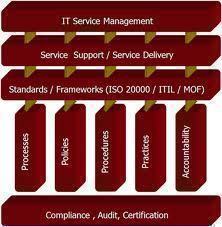ITIL Service Management
The Information Technology Infrastructure Library (ITIL) is a collection of concepts developed Information Technology Services Management, IT development, and operations. What ITIL did was provide a description of different IT practices that were important. It took these important practices and applied a checklist to it that an IT organization could then tailor to suit its specific needs. It made things much easier for IT firms because they now could follow a comprehensive check list.
ITIL Service Management
ITIL service management is the support necessary to ensure that customers have access to all necessary services needed to support a business function. Because the customers are the most important aspect to a business, the service management is responsible for trying to resolve the problem and, if it cannot resolve the problem, it relays it to a 2nd/3rd tier group that is more specialized in solving the problem.
The primary functions of the Service Desk are incident control and communication. Incident control is management over the life-cycle of all service requests. If there are requests that are being made, management keeps a close eye on them and are able to determine how far along a resolution is from being completed. The communication is the way in which customers are kept in the loop about what is going on. More importantly, though, is that the communication aspect advises on ways to work around the problem until a solution has been reached.
There are multiple features that make service management so beneficial to an IT organization. To begin with, there is single point of contact that makes it very easy for customers to deal with the IT organization. On top of that, there is both a single point of energy and exit. This means that there is less time wasted on getting the necessary information.
The three types of service desk names are call center, help desk and service desk. The call center handles a large number of telephone calls. Their goal is to handle them in a professional manner. The help desk tries to resolve incidents as quickly as possible. Finally, the service desk handles incidents, but also helps with change requests, maintenance contracts and many other IT services that a firm or customer might need help with.
ITIL Service Management Structures
There are three potential ITIL service management structures that an organization can employ. The first is the local service desk which is meant to service local businesses only. If your firm deals with businesses in one or two towns, this would be the ideal scenario. However, if you have multiple locations, a central service desk would be ideal because it reduces the costs of operations, but allows for an increase of available resources. Finally, for firms that are world-wide, there is a virtual service desk. This makes it possible to rely on the Internet and quick communication to get problems resolved.


Comments - No Responses to “ITIL Service Management”
Sorry but comments are closed at this time.